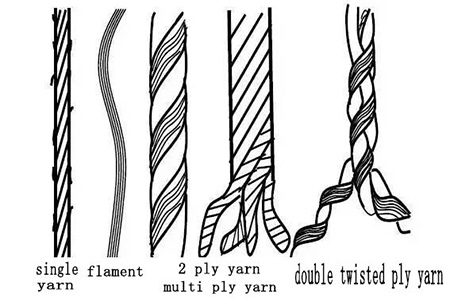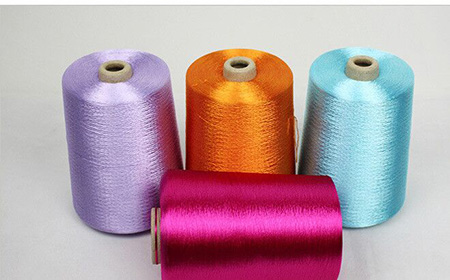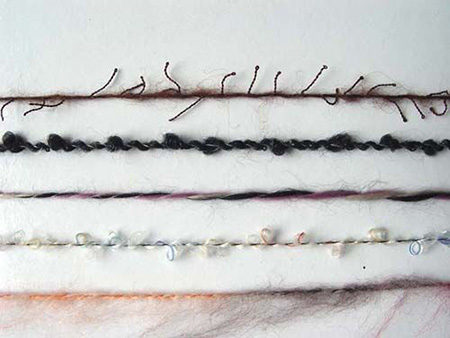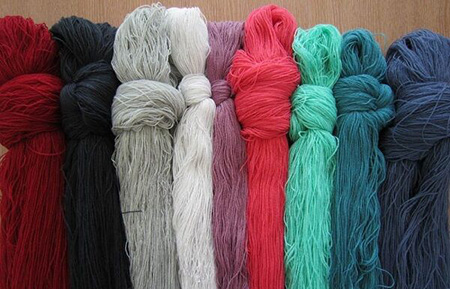Yarn Classification: Raw Materials, Technology, Structure, Use
2023-08-31
Yarn is a continuous fiber bundle composed of staple fibers or filament aggregates, generally including three types of yarns: staple yarn, filament yarn and fancy yarn. There are many types of yarns, with different properties. To fully understand the types and uses of yarns, Sinrylion professional polyester yarn manufacturer will start from four aspects: raw materials, processes, structures and uses.
Yarn raw material
The raw materials of yarn include short fiber and filament fiber: short fiber yarn includes cotton yarn, linen yarn, wool yarn, silk yarn, purified fiber yarn, blended yarn, etc. Filament fibers mainly refer to silk and chemical fiber filaments. As far as yarn is concerned, its raw materials are often composed of one or more fibers, namely single fiber yarn and blended yarn.
1.Monofilament Yarn
Yarns spun from one fiber raw material, such as pure cotton yarns, pure wool yarns, and pure viscose yarns, are suitable for making pure textiles and mainly reflect the basic properties of the fibers used.
2.Blended Yarn
Yarn blended from two or more different fiber materials, the purpose is to combine the advantages of various fibers, improve the performance of the yarn, and increase the variety of colors. Such as polyester-cotton blended yarn, wool and viscose blended yarn.
Spinning Process
1.Yarn twist: twist, twist direction
yarn twist in fabric
Yarn |
Twist |
Application Field |
Low Twist Yarn |
under 300 |
Wool, Knitted Fabrics, etc. |
Medium Twist Yarn |
300 ~ 1000 |
Softer Fabric |
Strong Twist Yarn |
1000 ~ 3000 |
Smoother Fabric, Folded Fabric |
Super Twist Yarn |
3000+ |
Folded Fabric |
Influence of Yarn Twisting Direction on Fabric
| Twill Direction Warp | Warp Twist | Weft Twist | Twill Definition |
| Twill | S | Z | Twill unclear |
| Left twill | S | Z | Twill unclear |
| Twill | Z | S | Twill unclear |
| Left Twill | Z | S | Twill unclear |
| Twill | S | S | Transparent Warp Twill |
| Left Twill | S | S | Clear Weft Twill |
| Twill | Z | Z | Clear weft twill |
| Left Twill | Z | Z | Transparent Warp Twill |
2.Carding yarn: carded yarn, combed yarn and waste yarn
Carded yarn is a yarn spun by a common spinning system.
Combed yarn is made of high-quality fibers and is spun with an additional combing process compared to carded yarn. Combed yarn has straighter fiber alignment, higher yarn strength, better luster and fewer defects.
Waste yarn, which is spun into yarn from waste cotton processed in the spinning process, is generally only used for weaving coarse cotton blankets, terry cloth and packaging cloth, etc.
|
Category |
Description |
|
Gray Yarn |
Also called primary yarn, the yarn is undyed and retains the original color of its fibers. |
|
Bleached Yarn |
Original color yarn becomes bleached yarn after practicing bleaching. |
|
Dyed Yarn |
The raw yarn is dyed before weaving and is used for yarn-dyed weaving. |
|
Mercerized Yarn |
After the yarn is mercerized, it is divided into mercerized bleached yarn and mercerized dyed yarn. |
|
Color Spinning |
The fibers are first dyed and then the colored fibers are spun into colored yarn. |
|
Inflatable yarn |
Yarns that have been polished and have a shinier finish. |
Morphological structure of the yarn
1.Yarn fineness/yarn count
Here we take cotton yarn and wool yarn as examples to illustrate the division of yarn fineness.
|
Classification |
Cotton or cotton-like yarn/Tex |
Wool or wool yarn/Nm |
|
Super Fine Yarn |
≤10 |
≥80 |
|
Spun Yarn |
11 ~ 20 |
32 ~ 80 |
|
Middle Yarn |
21 ~ 31 |
- |
|
Roving |
≥32 |
<32 |
Roving, cotton yarn over 32tex, mainly used for weaving thick fabrics or raised cotton fabrics. Such as coarse cloth, flannel, strong tweed and so on.
Medium yarn, 33~22tex cotton yarn, mainly used for weaving plain, twill, satin and other fabrics, cotton fabrics are widely used.
Spun yarn, cotton yarn of 21tex and below, is mainly used for high-end needle-punched and cotton fabrics, such as high-end poplin, high-end sweatshirts, undershirts, etc.
If you want to know more about yarn fineness, please refer to this article: Yarn fineness/yarn count expression method, conversion relationship, test method: Tex, Den, Nm, Ne
2.Yarn shape
Staple Fiber Yarn
Single yarn: It is directly spun from staple fibers and is mainly used as a raw material for fabrics.
Ply yarn: A thread formed by twisting two or more single yarns, which has better strength and wear resistance than single yarns. There are 2-ply yarn, 3-ply yarn and multi-ply yarn such as sewing thread, embroidery thread and knitting thread.
Double-twisted stranded wire: It is twisted by two or more strands of stranded wire and is mainly used for decorative threads, ropes, etc.

Short fiber yarns generally have a loose structure, have more air content, more wool, and less luster, so they have good hand feel and covering power. Woven fabrics have better comfort and appearance properties, proper strength and uniformity.
Filament Yarn
Filament yarn is made by twisting or untwisting one or more filaments, mainly including ordinary filaments and special-shaped filaments.
Ordinary Filament Type
Functions and Applications
Monofilament
Composed of filaments, the diameter depends on the fineness of the filaments. Generally it is only used to process thinner fabrics or knitted fabrics, such as nylon socks, face towels, etc.
Composite Filament
Composite filament is composed of multiple monofilaments. Many silks are woven from composite filaments such as plain weave and powerspun.
Composite Twisted Yarn
Composite twisted filaments, such as silk-like crepe fabrics made of multi-twisted filaments.
Deformed Filament Type
Functions and Applications
High Elastic Yarn
It has high elasticity and average bulkiness. It is suitable for elastic tight-fitting shirts, pants, elastic socks and other elastic fabrics, mainly nylon high elastic yarn.
Low Stretch Yarn
Moderate elasticity and bulkiness, suitable for fabrics and decorative fabrics that do not require high elasticity but have good appearance, feel and dimensional stability. Polyester low-elastic yarn is the main material, and polypropylene low-elastic yarn is often used to make carpets.
Textured Yarn
Bulk yarn has low elasticity and high bulkiness, bulky volume, rich hand and elasticity, and is used to make polar fleece, imitation tweed, knitted outerwear, hats and scarves. A typical representative is acrylic bulked yarn.
Mesh
Some monofilaments have periodic misalignments, bends and twists that increase the holding force and can replace twists. This kind of silk feels soft and fluffy, has a good wool-like effect, and is mostly used in women's tweed.

Filament yarn has smooth surface, good luster, low friction and poor covering ability. However, it has good strength and uniformity and can be woven into finer yarns. The fabric woven with it feels smooth, cool, bright and smooth, and its strength and wear resistance are better than those of short-fiber yarn fabrics.
Fancy Yarn
In addition to short fiber yarns and filament yarns, a class of fancy yarns are also produced to enrich the appearance of fabrics and improve their wearing properties.

Fancy yarn is a yarn with special appearance, feel, structure and texture obtained through various methods, which is mainly manifested in various color and shape changes on the yarn. The fancy yarn enriches the appearance of the fabric, and also improves some wearing properties of the fabric.
Sinrylion has been a fancy yarn manufacturer for 40 years, producing various types of fancy yarns.
Yarn uses
1. The warp yarn is used as the warp yarn for weaving. Since the warp yarn is subject to great tension and friction during the weaving process, it is required to have high strength and appropriate twist.
2. Weft yarn is used for weaving. Since the weft yarn does not bear more tension and friction during weaving, the strength of the weft yarn is smaller than that of the warp yarn, but it needs a certain degree of softness and twist stability. The twist should not be too much.
3. Knitting yarn is required to be soft and smooth, smooth through knitting crochet needles, so the knitting yarn is clean and uniform, and the twist is lower than that of warp and weft yarns.
4. Cheese, yarn removed from the winder and wound in bobbins.
5. Coiled yarn is a yarn wound from a package yarn according to the specified length and number of turns. For example, the length of cotton yarn is 1000 meters, which is called "one roll". Its shape is suitable for inspection and dyeing processing, and is convenient for packaging, transportation and storage.

 English
English 한국어
한국어 বাংলা ভাষার
বাংলা ভাষার हिन्दी
हिन्दी Türkçe
Türkçe русский
русский




